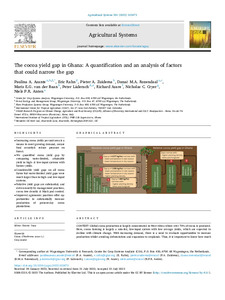| dc.contributor.author | Asante, P.A. |
| dc.contributor.author | Rahn, E. |
| dc.contributor.author | Zuidema, P.A. |
| dc.contributor.author | Rozendaal, D.M.A. |
| dc.contributor.author | van der Baan, M.E.G. |
| dc.contributor.author | Laderach, P. |
| dc.contributor.author | Asare, R. |
| dc.contributor.author | Cryer, N. |
| dc.contributor.author | Anten, N.P.R. |
| dc.date.accessioned | 2022-09-14T09:34:21Z |
| dc.date.available | 2022-09-14T09:34:21Z |
| dc.date.issued | 2022-08 |
| dc.identifier.citation | Asante, P.A., Rahn, E., Zuidema, P.A., Rozendaal, D.M.A., van der Baan, M.E.G., Läderach, P., ... & Anten, N.P.R. (2022). The cocoa yield gap in Ghana: a quantification and an analysis of factors that could narrow the gap. Agricultural Systems, 201: 103473, 1-13. |
| dc.identifier.issn | 0308-521X |
| dc.identifier.uri | https://hdl.handle.net/20.500.12478/7744 |
| dc.description.abstract | CONTEXT Global cocoa production is largely concentrated in West Africa where over 70% of cocoa is produced. Here, cocoa farming is largely a rain-fed, low-input system with low average yields, which are expected to decline with climate change. With increasing demand, there is a need to evaluate opportunities to increase production whilst avoiding deforestation and expansion to croplands. Thus, it is important to know how much additional cocoa can be produced on existing farmland, and what factors determine this potential for increased yield. OBJECTIVE The objective was to quantify the cocoa yield gap in Ghana and identify the factors that can contribute to narrowing the gap. METHODS We calculated the cocoa yield gap as the difference between potential yield (i. water-limited potential(Yw) quantified using a crop model, ii. attainable yield in high-input systems(YE), iii. attainable yield in low-input systems(YF)) and actual farmer yield. Both absolute and relative yield gaps were calculated. We then related each yield gap (absolute & relative) as a function of environment and management variables using mixed-effects models. RESULTS AND CONCLUSIONS There were considerable yield gaps on all cocoa farms. Maximum water-limited yield gaps (YGW) were very large with a mean absolute gap of 4577 kg/ha representing 86% of Yw. Attainable yield gap in high-input (YGE) was lower with mean absolute gap of 1930 kg/ha representing 73% of YE. The yield gap in low-input (YGF) was even lower with mean absolute gap of 469 kg/ha representing 42% of YF. Mixed-effects models showed that, absolute YGW were larger at sites with higher precipitation in the minor wet and minimum temperature in the minor dry season explaining 22% of the variability in YGW. These same factors and cocoa planting density explained 28% of variability in absolute YGE. Regardless of climate, absolute YGF and relative YGW, YGE and YGF were reduced by increasing cocoa planting density and application of fungicide against black pod. The models explained 25% of the variability in absolute YGF, and 33%, 33% and 25% in relative YGW, YGE and YGF respectively. In conclusion, climate determined absolute YGW in Ghana whilst absolute YGE were determined by both climate and management. In contrast, absolute YGF and relative YGW, YGE and YGF can be reduced by agronomic management practices. SIGNIFICANCE Our study is one of the first to quantify cocoa yield gaps in West Africa and shows that these can be closed by improved agronomic practices. |
| dc.description.sponsorship | Norwegian Agency for Development Cooperation |
| dc.format.extent | 1-13 |
| dc.language.iso | en |
| dc.subject | Cocoa |
| dc.subject | Theobroma Cacao |
| dc.subject | Yields |
| dc.subject | Spacing |
| dc.subject | Ghana |
| dc.title | The cocoa yield gap in Ghana: a quantification and an analysis of factors that could narrow the gap |
| dc.type | Journal Article |
| cg.contributor.affiliation | Wageningen University and Research Centre |
| cg.contributor.affiliation | International Center for Tropical Agriculture |
| cg.contributor.affiliation | Alliance of Bioversity International and CIAT |
| cg.contributor.affiliation | International Institute of Tropical Agriculture |
| cg.contributor.affiliation | Mondelez UK R&D Ltd |
| cg.coverage.region | Africa |
| cg.coverage.region | West Africa |
| cg.coverage.country | Ghana |
| cg.coverage.hub | Headquarters and Western Africa Hub |
| cg.researchtheme | Natural Resource Management |
| cg.identifier.bibtexciteid | ASANTE:2022 |
| cg.isijournal | ISI Journal |
| cg.authorship.types | CGIAR and advanced research institute |
| cg.iitasubject | Agronomy |
| cg.iitasubject | Biodiversity |
| cg.iitasubject | Climate Change |
| cg.iitasubject | Cocoa |
| cg.iitasubject | Disease Control |
| cg.iitasubject | Farming Systems |
| cg.iitasubject | Livelihoods |
| cg.iitasubject | Plant Breeding |
| cg.iitasubject | Plant Production |
| cg.journal | Agricultural Systems |
| cg.notes | Open Access Article; Published online: 28 Jul 2022 |
| cg.accessibilitystatus | Open Access |
| cg.reviewstatus | Peer Review |
| cg.usagerightslicense | Creative Commons Attribution 4.0 (CC BY 0.0) |
| cg.targetaudience | Scientists |
| cg.identifier.doi | https://dx.doi.org/10.1016/j.agsy.2022.103473 |
| cg.iitaauthor.identifier | Richard Asare: 0000-0001-6798-7821 |
| cg.futureupdate.required | No |
| cg.identifier.issue | 103473 |
| cg.identifier.volume | 201 |

